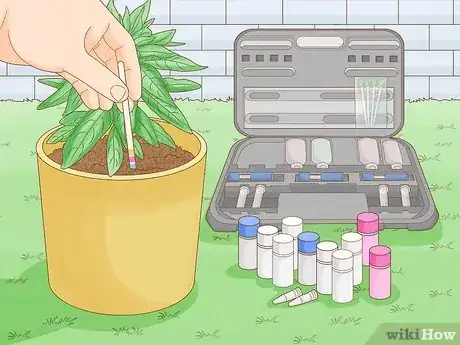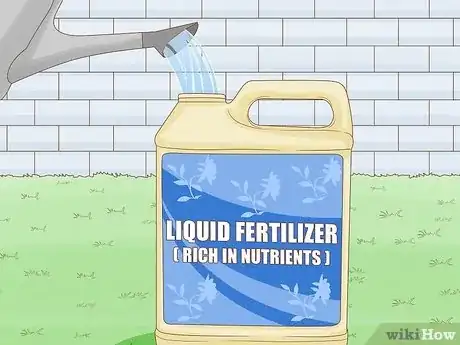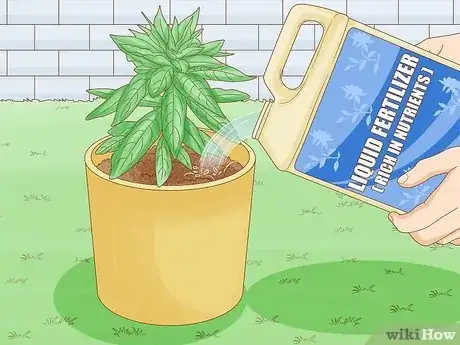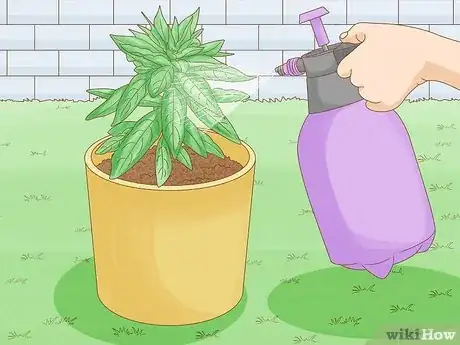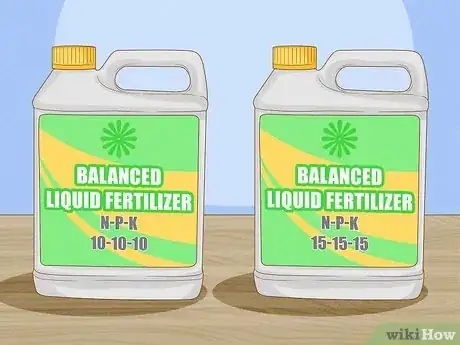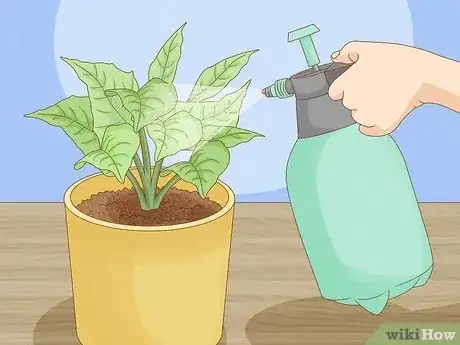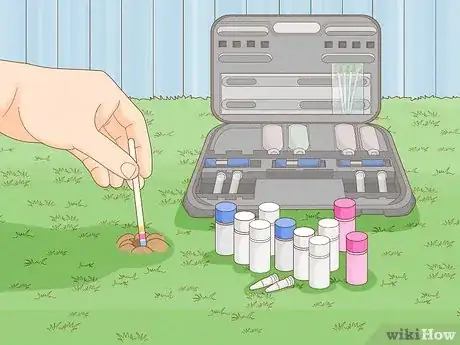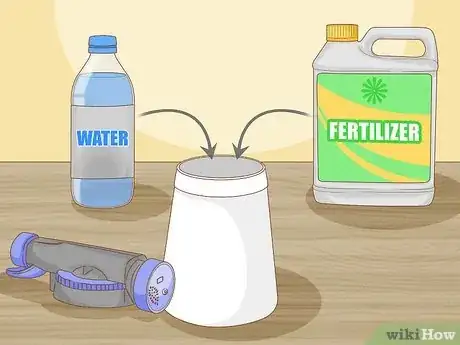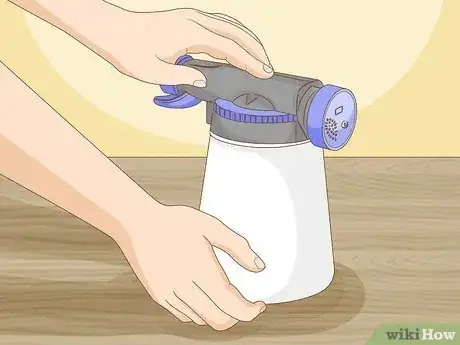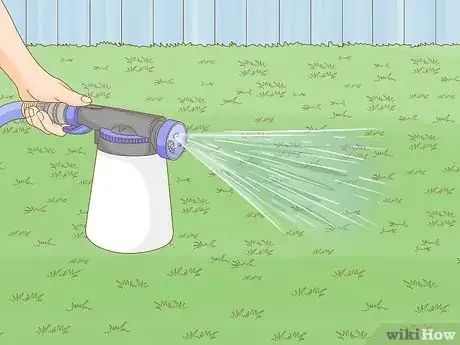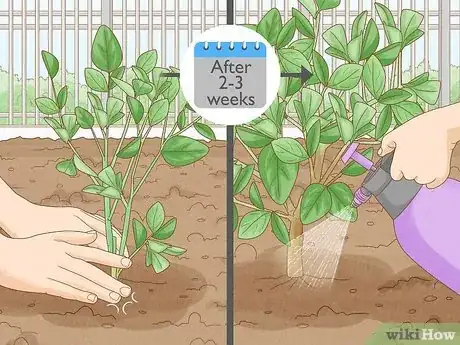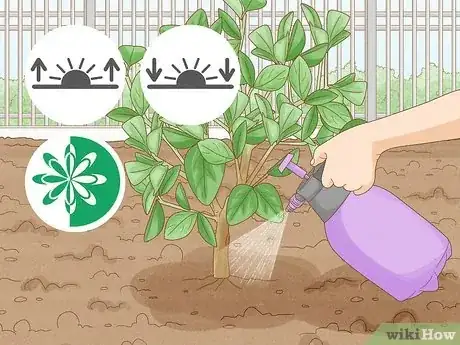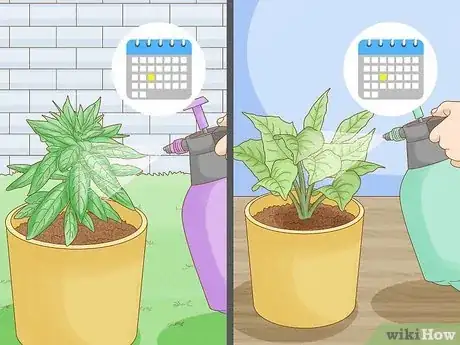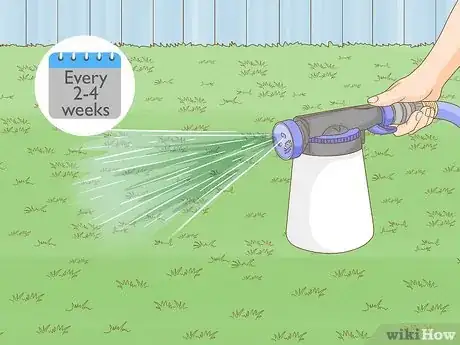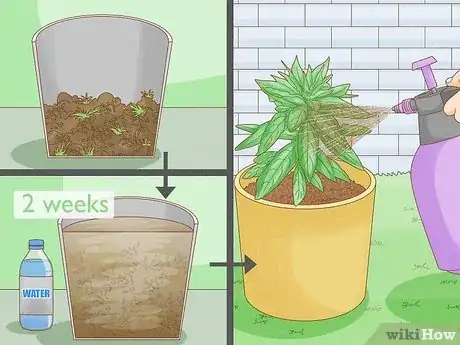This article was co-authored by Matt Bowman and by wikiHow staff writer, Hunter Rising. Matt Bowman is a Gardener, Landscaper, the Owner of Georgia Farm to Table, and the Owner of Tradition Property Services in Atlanta, Georgia. With over 20 years experience, he specializes in organic gardening, landscape maintenance, handyman services, homecare services, and supplying Christmas trees. Matt earned a BA in Journalism from the University of Georgia.
There are 17 references cited in this article, which can be found at the bottom of the page.
This article has been viewed 3,513 times.
If you're looking for a quick way to feed your plants or lawn, liquid fertilizer is a great way to stimulate healthy growth. Liquid or water-soluble fertilizers seep into the soil or the leaves of your plants a quick and even balance of nutrients they need, and they're so easy to use no matter what you’re growing. Keep reading for the answers to your most common questions and find out how you can apply liquid fertilizer to help any of your plants thrive!
Things You Should Know
- To fertilize outdoor plants, run a soil test to know what nutrients are missing. Dilute a liquid fertilizer with water in a watering can and pour it onto the soil.
- For indoor or container plants, use a balanced NPK liquid fertilizer. Dilute the fertilizer with water and apply it to the soil or directly on the leaves.
- To use liquid fertilizer on your lawn, do a soil test to see what fertilizer nutrients it needs. Use a garden sprayer or a hose to spread the fertilizer.
- Apply liquid fertilizers every 2–4 weeks in the early morning or late evening before the hot midday sun.
Steps
Fertilizing Outdoor Plants
-
1Run a soil test to see what nutrients your plants need. Get a soil test kit and take a sample of the soil in the area near your plants. Test the soil sample following the instructions in the kit to check the nutrient levels that are already in your soil. That way, you get a better idea of what you need to add to your soil so that your plants can thrive.[1]
- If your soil already has high levels of nutrients, then you don’t need to apply any liquid fertilizer.
-
2Dilute a liquid fertilizer with water in a watering can. Based on what you found out from your soil test, get a liquid fertilizer that’s rich in the nutrients that are missing. Every liquid fertilizer has a different concentration, so follow the directions that are on the packaging to find out how much to use. Put water and the fertilizer in a watering can and give a quick stir to ensure the solution is thoroughly mixed.[2]
- Some liquid fertilizers come in a bottle that connects directly to the end of a hose. The fertilizer mixes with the water once you turn your hose on, so you don’t have to dilute it.
- If you have irrigation for your outdoor plants, you can put the liquid fertilizer into a fertilizer injector connected to the line. That way, your plants will get fertilizer every time they’re watered.
Advertisement -
3Wet the soil around your plants with the fertilizer solution. Slowly pour the fertilizer solution directly onto the soil around the base of your plants to feed and water them at the same time. Only wet the soil enough so it feels damp, but not so there are standing pools of water on the surface.[3]
- Give liquid fertilizer to the plants in your garden to help them produce more fruits and veggies you can harvest.
- Liquid fertilizer is great for newly planted trees or shrubs so they can develop strong trunks and branches.
- Try liquid fertilizer on your flowers when they’re in bloom to help them stay bright and colorful throughout the season.
-
4Apply fertilizer to the leaves with a garden sprayer for a quick boost. Unlike granular varieties, liquid fertilizers can be used as a foliar application, meaning they absorb through the leaves of your plant. If your plants need a little perk up in the middle of the growing season, dilute your fertilizer in a garden sprayer or spray bottle and mist the leaves until they start to drip. Your plants will get a healthy boost and grow in stronger.[4]
- Any excess fertilizer that drips off will absorb into the soil and be sucked up by your plant’s roots.
Fertilizing Indoor Plants
-
1Use a balanced NPK liquid fertilizer for your plants. A balanced fertilizer has equal parts nitrogen (N), phosphorus (P), and potassium (K), which are all helpful nutrients to stimulate plant growth. Check the packaging on the fertilizer to see if the 3 numbers listing the nutrient amounts are the same, such as “10-10-10” or “15-15-15.”[5]
- You do not need to run a soil test for container plants since most potting mixes already say what nutrients they contain.
- Fertilizers are great for promoting blooms, as well as supporting indoor and potted plants after you transplant them into new containers.
- If you’re growing tomatoes or planting bell peppers, use a liquid fertilizer with a higher amount of potassium to help your plants grow more fruits.
-
2Dilute the fertilizer in a watering can. Read the label on the packaging to determine the ratio of fertilizer to water you need. Usually, you’ll use about 1 tablespoon (15 ml) of fertilizer per 1 gallon (3.8 L) of water. Put the water and fertilizer in your watering can and swish it around to ensure they’re mixed together.[6]
- Some fertilizers for indoor and potted plants are already diluted in the bottle, so they’re ready to use right away. Always read the instructions on the package thoroughly to see if you need to add water.
-
3Soak the soil with your fertilizer solution. Pour the fertilizer solution directly onto the soil to water and feed your indoor potted plants at the same time. Let the fertilizer seep into the soil so it comes out of the drainage holes at the bottom of the pot. Just be sure to stop adding fertilizer before water starts pooling on the surface.[7]
-
4Spray fertilizer on the leaves if your plants are stressed. If you ever accidentally forget to water or feed your plant, then your plants can use the extra boost from a little liquid fertilizer in the middle of the growing season. Put the diluted fertilizer into a spray bottle or garden sprayer and apply it directly on the leaves. You’ll see your plant perk up within the next couple of days.[8]
Fertilizing Your Lawn
-
1Perform a soil test to find out what nutrients your lawn is missing. Take a sample of soil from your lawn and run your soil test. When you see the results, make note of which nutrients your lawn needs so you can get a liquid fertilizer that contains them.
- Liquid fertilizers help give your grass a quick boost of green in the middle of the growing season.
- You only need to test your soil once every 3–5 years to monitor the nutrient levels.[9]
-
2Pour liquid fertilizer in a garden sprayer and dilute it with water. A garden sprayer is the best way to apply liquid fertilizer to your lawn since you get the most even coverage. Check the fertilizer package to see how much you need to mix with water to get the proper concentration.[10]
- The concentration of different liquid fertilizers will vary. If you accidentally use too high of a concentration, it could “burn” your grass and damage your lawn.
-
3Attach the fertilizer bottle to a hose if it has a hose-end applicator, alternatively. Some liquid fertilizers come in a bottle that screws directly to the end of a garden hose. When you turn on your hose, the fertilizer automatically mixes with the water so it’s at the proper concentration. That way, you don’t have to worry about measuring or diluting the fertilizer.[11]
- Most fertilizers with hose-end applicator bottles can cover 2,500 square feet (230 m2) of your lawn.[12]
-
4Spread the fertilizer evenly over your lawn. Start in the corner of your lawn and spray the fertilizer onto your grass in rows back and forth. Walk backward to avoid stepping on any areas you just applied your fertilizer. The fertilizer will absorb through the blades of grass and the soil to help promote healthy growth.[13]
- Try applying fertilizer right after you mow your lawn so the grass has more time to absorb the nutrients before you mow again.
Warnings
- Avoid getting fertilizer on pavement or hard surfaces so it doesn’t wash into a storm drain and contaminate water.[21]⧼thumbs_response⧽
- If it’s about to rain, wait to apply fertilizer since it could easily wash off your plants and leach into groundwater.⧼thumbs_response⧽
References
- ↑ https://www.almanac.com/how-fertilize-your-vegetable-garden
- ↑ https://youtu.be/qPRbs8pvvhE?t=262
- ↑ https://hgic.clemson.edu/factsheet/fertilizing-trees-shrubs/
- ↑ https://turf.arizona.edu/ccps101.htm
- ↑ https://www.almanac.com/abcs-fertilizing-containers
- ↑ https://youtu.be/aA03SAuEnWE?t=129
- ↑ https://youtu.be/7jrfNglwIJE?t=6013
- ↑ https://www.almanac.com/abcs-fertilizing-containers
- ↑ https://www.riley.k-state.edu/lawn-garden/soil-testing-fertilizing/index.html
- ↑ https://turf.arizona.edu/tipsnov00.htm
- ↑ https://youtu.be/KgLVENZ4hVo?t=148
- ↑ https://youtu.be/HvtY4ifl98c?t=145
- ↑ https://youtu.be/V2m73Hr-tkE?t=311
- ↑ https://www.almanac.com/how-fertilize-your-vegetable-garden
- ↑ https://ipm.missouri.edu/MPG/2019/4/foliarFeeding/
- ↑ https://gardeningsolutions.ifas.ufl.edu/care/fertilizer/applying-fertilizer-to-vegetables.html
- ↑ https://extension.umd.edu/resource/fertilizer-indoor-plants
- ↑ https://extension.umn.edu/yard-and-garden-news/hot-weather-fertilizer-tips-your-yard-and-garden
- ↑ https://www.almanac.com/how-fertilize-your-vegetable-garden
- ↑ https://www.almanac.com/fertilizer-tea-plants-weeds-and-grass
- ↑ https://gardeningsolutions.ifas.ufl.edu/care/fertilizer/applying-fertilizer-to-vegetables.html
